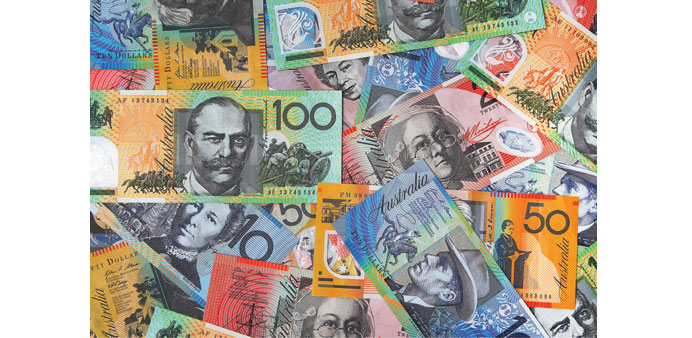Australian dollar banknotes of various denominations are arranged for a photograph in Sydney. The Aussie has slumped 38% since July 2011, yet the cost of living has risen only 8%, according to data compiled by Bloomberg.
Bloomberg
Sydney
It used to be a simple mathematical proposition. When a country’s currency tumbled, its consumer prices would rise as the cost of imported goods climbed.
When Australia embraced a flexible exchange rate in 1983, that’s certainly what happened. The consumer price index soared 16% as the local dollar depreciated 38% from March 1984 to July 1986.
In the post-global financial crisis era, the principle appears to have been diluted. The Aussie has slumped 38% since July 2011, yet the cost of living has risen only 8%, according to data compiled by Bloomberg.
That wouldn’t be a problem if the cheaper currency was spurring manufacturing exports and workers’ pay packets. But those aren’t rising either. For the central bank, it means the exchange rate is no longer the powerful tool it once was, increasing the burden on Australian policy makers.
Partly to blame: there’s just not much inflation anywhere, outside of pockets in emerging markets like Latin America.
So there’s not much to import through a cheaper currency. For Reserve Bank of Australia Governor Glenn Stevens, the lack of price pressures is uncommon for a country that has battled inflation higher than in major developed economies for most of the past 30 years.
“Stevens may have been too hawkish, relying on a past that has proved to be an unreliable guide for the future,” said James McIntyre, head of economic research at Macquarie Group Ltd in Sydney and a former Treasury official. “Generating inflation rather than fighting it is the global challenge.”
McIntyre predicts Australia’s central bank will further cut its already record-low benchmark interest rate of 2% early next year.
Stevens pondered the weakness in global inflation in a speech Tuesday, noting that while outright deflation was relatively rare, consumer-price growth below target was common - - despite zero interest rates and quantitative easing in the US, the UK and Europe.
“For economists and policymakers trained from the 1960s to the 1990s, when the task was always to stop inflation rising and/or to get it down, this is a remarkable outcome,” he said.
The governor confirmed that very low inflation in Australia in the three months through September “contained some signal, not just noise” and added that “the effects of a decline in the exchange rate are proving a bit slow to come through.” Australia’s inflation rate was 1.5% in the third quarter, below the central bank’s 2% to 3% target.
Australia ended controls on its exchange rate in December 1983 and long-term periods of depreciation since then have come in four main waves, excluding a sharp drop in the currency during the global financial crisis and an equally quick recovery: March 1984 to July 1986: the currency slid 38%, while the consumer price index climbed 16% February 1989 to September 1993: the local dollar fell 28% and the CPI increased 18%December 1996 to April 2001: the Aussie dropped 42% and the CPI rose 11 July 2011 to September 2015: the currency fell 38% and the CPI rose 8%. A deeper issue for Stevens and Federal Treasurer Scott Morrison is the weakest pace of wage gains since the last recession, a quarter century back.
The stagnation in real wage growth in Australia partly reflects the winding down of the resources boom as high-paying mine jobs are lost and an increasing number of people are employed in service industries that are more competitive with a lower currency. What’s confounding many economists both in Australia and globally is why workers’ pay rates aren’t rising even though the labour market is improving.
“When labor costs stagnated in the early 1990s, unemployment averaged about 11% for two years, which was the highest rate since the Great Depression,” said Kieran Davies, chief economist at Barclays Plc and a former Treasury official. Unemployment today is just over 6%.



